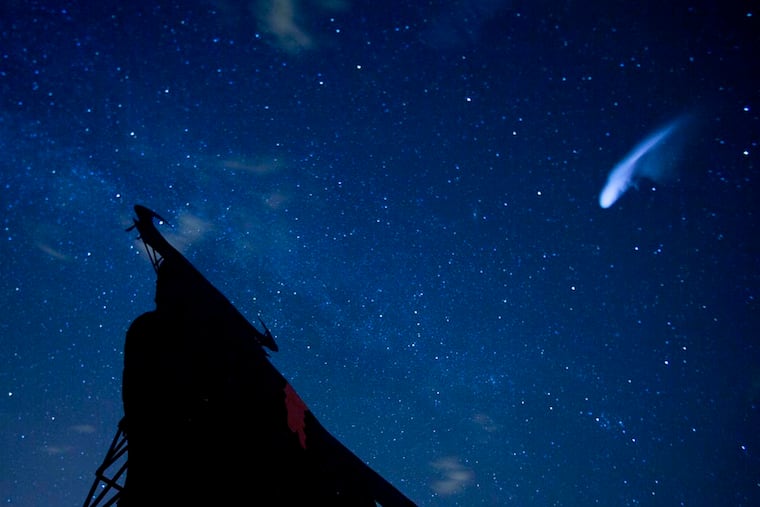The Perseid meteor showers are approaching, but you better not wait to see them
One of the year’s most anticipated and popular night-sky shows is likely to be usurped by the moon.

Just as the Perseid meteor showers are approaching their annual peak, what usually would be one of the year’s most anticipated and popular night-sky shows is going to be all but mooned out.
But a prelude already is well underway, and with the moon interference minimal, hard-core sky watchers and insomniacs still can catch glimpses of the falling stars, perhaps as many as 10 an hour in the coming days, says the American Meteor Society’s Robert Lunsford.
While this won’t be a stellar year for Perseids — he’s already looking forward to 2023, and especially 2028 — the night sky is always worth a look, says Lunsford. “There’s all kinds of stuff to keep you entertained up there,” he said. And even in an off year, the Perseids would qualify.
What are these things
Earth’s atmosphere has the power to transform cosmic detritus to what are commonly called “shooting stars.” Fragments of comets and other material that can range in size from grains of sand to pebbles are vaporized as they enter the atmosphere, transformed to the likes of celestial fireflies, or sometimes even fireballs.
» READ MORE: Is space tourism ready for take-off?
Several might be visible on any given night, but during meteor showers the numbers bump up substantially. That’s the case with the Perseids, set off when Earth’s orbit intercepts the leftover debris of the comet Swift-Tuttle, named for Lewis Swift and Horace Tuttle, who discovered it in the 19th century.
The particles enter the atmosphere 50 to 75 miles up and become incandescent as they hurtle at 130,000 mph, NASA says. They appear as streaks in the sky, and bigger fragments can explode into fireballs.
The comet visits our solar system every 133 years, and Connor Marti, with Rowan University’s Edelman Planetarium, noted that Swift-Tuttle replenished the supply of meteor-making debris in 1992 on its last approach. The supplier is due back in August 2125.
The Perseids can produce 50 to 100 meteors an hour at their peak, which is due Aug. 12-13, but evidently no one will be seeing 50 meteors an hour this year, said Lunsford.
About the moon
In any given year, it is all but impossible to predict how many meteors will pop from the Perseids, given that a comet’s “individual particles” can’t be observed, said Rowan’s Marti.
Plus the Perseids have been known to pull surprises. Lunsford said that in 2016, Jupiter was aligned in such a way that its gravitation pull resulted in shaking loose more cometic debris. After the 2021 Perseid peak, he said, his video scanner captured 400 meteors in one night.
» READ MORE: The moon is quite a forbidding, and fascinating place
Unfortunately for meteor watchers, the waxing moon, which reaches fullness on Aug. 11, is wholly predictable. It doesn’t set until 2:41 a.m. Aug. 9, and stays in the sky even longer on subsequent nights. The brightness will obscure many of the stars, let alone the meteors. “The full moon will scatter a lot of light, said Lunsford.
Still, he said, you might be able to see some meteors if you face north away from the moon.
He already is excited about 2028, when that Jupiter effect is due to return.
“I will be out no matter what the moon is,” he said.
When and where
The meteors are called the Perseids because they appear to emanate from the constellation Perseus.
With the expected viewing conditions, in the Philly area, you would have a better chance of seeing Elvis at Broad and Chestnut than making out constellations in the night sky. And Lunsford points out they can show up all over the sky.
The best time to look would be very late at night into the early-morning hours. The more open the viewing area and the darker the sky, the better.
» READ MORE: Pennsylvania does have celebrated dark-sky oasis
Dark sky is scarce and getting scarcer around here. Pennsylvania hosts one of the most celebrated venues with Cherry Springs State Park, in Coudersport, Potter County, but this time around you’re probably better off not straying far from home or your vacation spot.
As NASA advises, “This is probably not the year to make a special trip in order to see the Perseids.”
Sky and Telescope recommends trying your luck on “multiple mornings.” The Perseids start appearing in mid-July and gradually pick up the pace approaching the peak. By Friday and Saturday, about 10 an hour should be visible, Lunsford said.
The National Weather Service provides hourly sky condition forecasts for the next six days.
Meanwhile things should be looking up in 2023 as the moon will be virtually a nonfactor. “Next year will be better,” said Lunsford.
Philadelphia sports fans can relate.